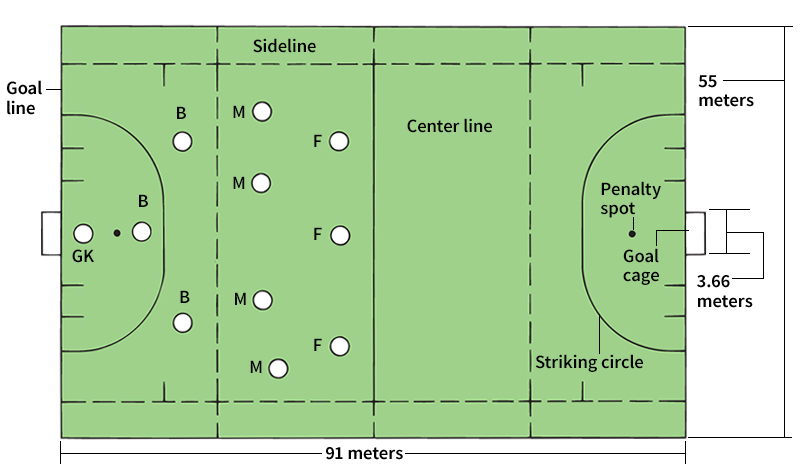Field hockey is a fast and exciting team sport in which players use sticks to try to hit a ball into their opponents’ goal. In the United States, field hockey is played primarily by girls and women, but it is a popular male sport in many other countries.
The field and equipment.
The teams compete on a smooth grass or artificial turf field 100 yards (91 meters) long and 60 yards (55 meters) wide. Various lines divide the field into sections. A goal line runs along the width of the field at each end. A wide arc called a striking circle extends from each goal line. A center line, also called a midfield line, parallel to the goal lines divides the field in half.

A goal cage stands in the center of each goal line. The cage has two goal posts 7 feet (2.13 meters) high and 12 feet (3.66 meters) apart. The posts are connected by a crossbar. A net is attached to the posts and crossbar. A backboard 18 inches (46 centimeters) high and 12 feet (3.66 meters) long is placed inside the net. Sideboards the height of the backboard are attached to the backs of the goal posts at right angles to the goal line.
Each player carries a stick with a curved end that is flat on its left side and rounded on its right. Only the flat side may be used to hit the ball. Most players use sticks that vary from 34 to 37 inches (86 to 94 centimeters) in length. The ball is about 9 inches (23 centimeters) in circumference and weighs about 51/2 ounces (160 grams). The outer surface is smooth. The inside may be either solid or hollow.
The game
is divided into two halves and varies in length from 50 to 70 minutes. Older and more skillful players compete in the longer games. Each team has 11 players. The most common setup consists of three forwards, four midfielders, three backs, and a goalkeeper. Two umpires supervise the game, sometimes aided by one or two timekeepers.
Players try to move the ball using only their sticks until they are in a position to shoot it into the other team’s goal. Each goal counts 1 point. A goal is scored each time an offensive player hits the ball from within the striking circle so it crosses the goal line between the goal posts.
The game starts with a center pass. A player from one team hits or pushes the ball with the stick from the midfield line to a teammate. At the time of the center pass, no players of the opposing team may be within 5 yards (4.6 meters) of the ball. All players except the one executing the center pass must remain in their own half of the field. The ball may be played in any direction once the game begins. Play resumes with a center pass after each goal.
The rules allow no body contact or dangerous hitting and prohibit a player from playing a ball above shoulder height with any part of the stick except when stopping a shot on goal. The goalkeeper may kick the ball or stop it with any part of the body, including the hand, but only when the ball is inside the striking circle.
History.
The origin of field hockey is unknown. Ancient Greek carvings show players using crooked sticks to hit a small object. Only men played field hockey for many years. In 1889, the All England Women’s Hockey Association was established. Constance M. K. Applebee of the British College of Physical Education promoted field hockey in the United States during the early 1900’s. The United States Field Hockey Association (USFHA) for women was organized in 1922. The Field Hockey Association of America (FHAA) for men was formed in 1928. The USFHA and the FHAA merged in 1993 under the USFHA name.
Men’s field hockey has been part of the Summer Olympics since 1908. Women’s field hockey became an Olympic sport at the 1980 Summer Games. Rules are made by the International Hockey Federation’s Rules Board and are the same for men and women.
